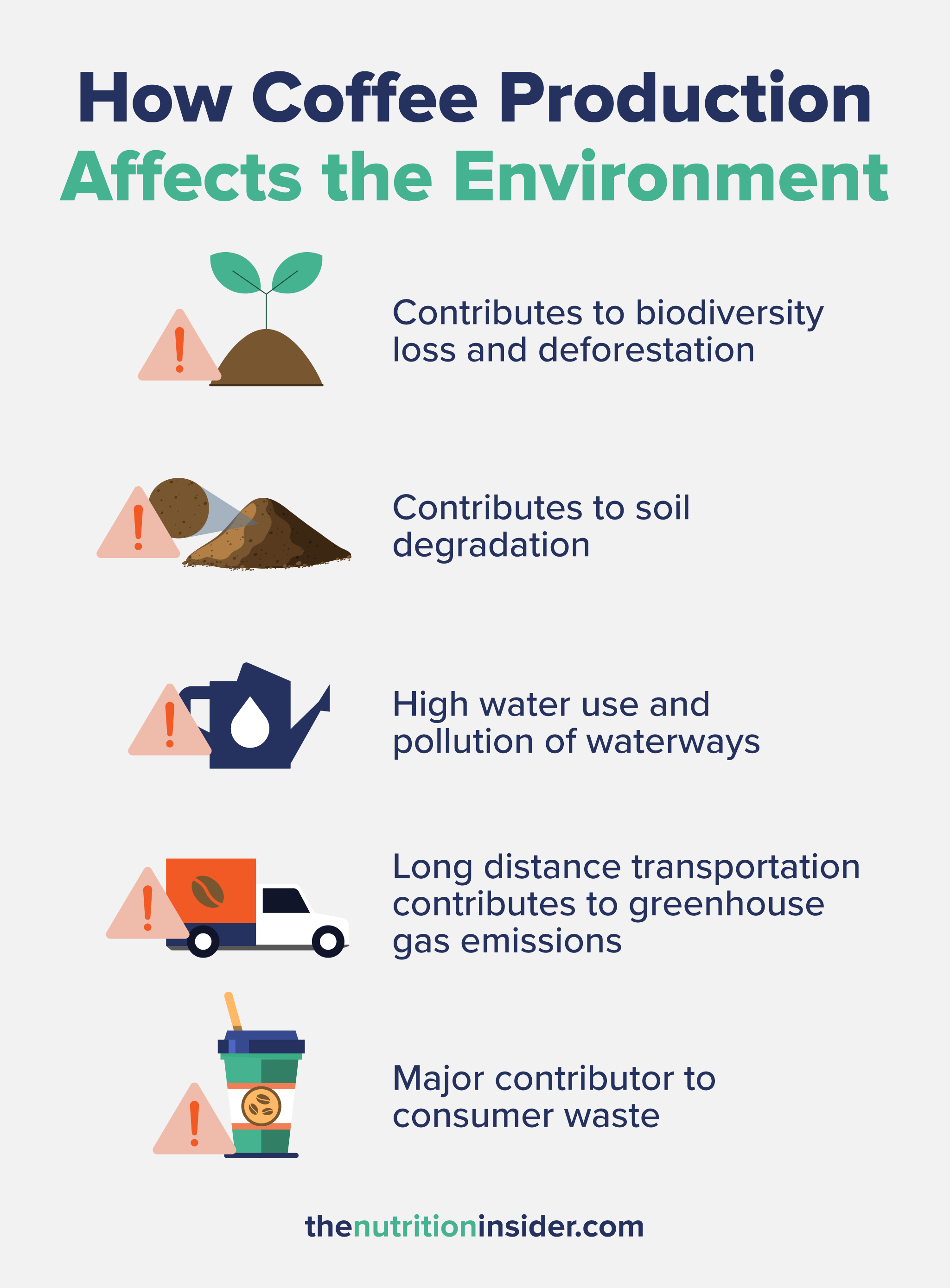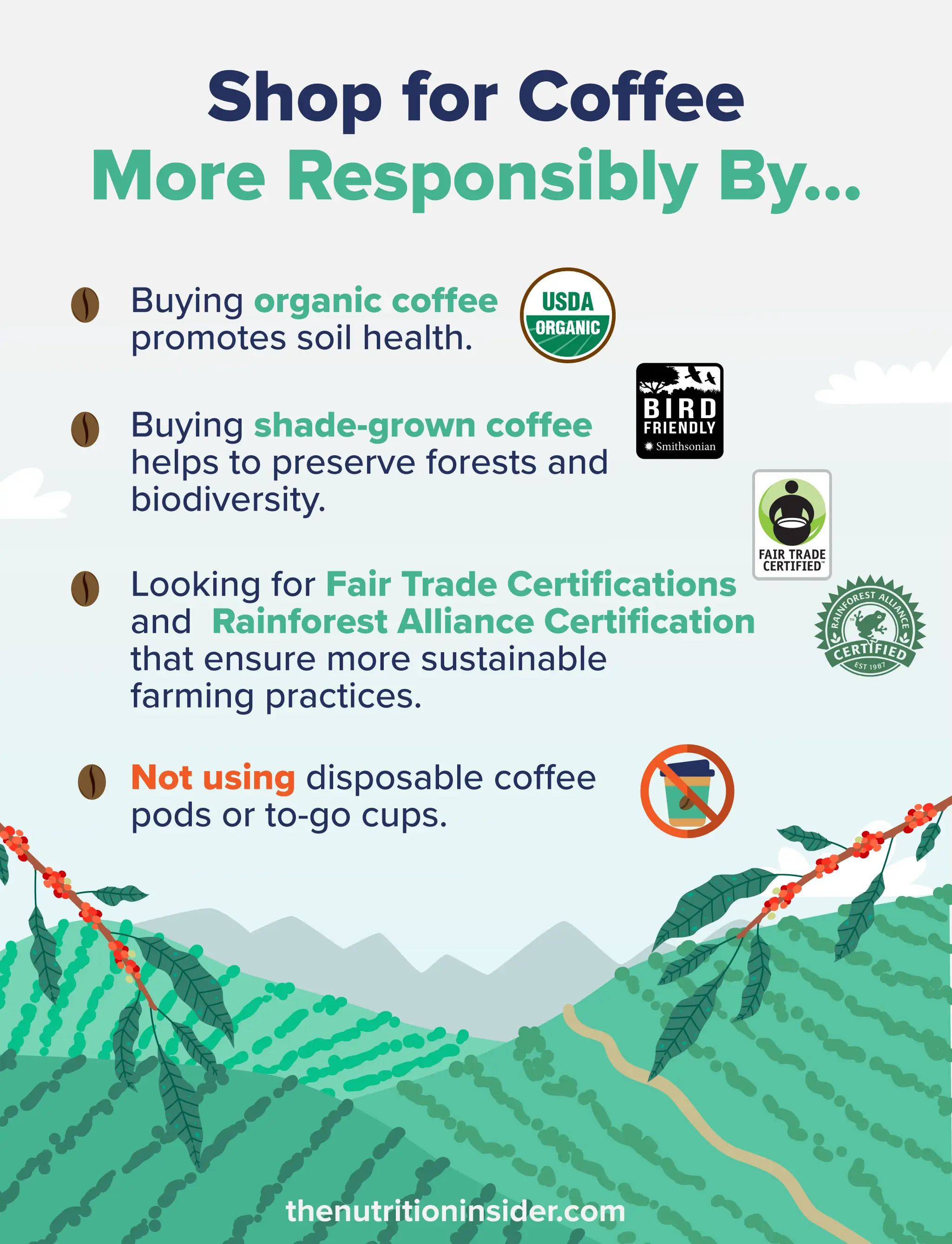Save $40 on your initial consult with a TNI Dietitian!
Talk to a real Dietitian for only $99: Schedule Now
This post contains links through which we may earn a small commission should you make a purchase from a brand. This in no way affects our ability to objectively critique the products and brands we review.
Evidence Based Research To fulfill our commitment to bringing our audience accurate and insightful content, our expert writers and medical reviewers rely on carefully curated research.
Read Our Editorial Policy
Our modern society is undoubtedly addicted to coffee (and lattes, Frappuccinos, cappuccinos, macchiatos, and any other number of espresso-based drinks).
But does this worldwide addiction have more of an impact than just on our energy levels and anxiety? Is coffee bad for the environment? Well, as it turns out, yes.
Conventional coffee production is highly unsustainable and can lead to a myriad of environmental impacts ranging from deforestation and soil erosion to water pollution and greenhouse gas emissions.
Fortunately, the growing awareness of coffee sustainability has led many brands to focus on how to make the farming, growing, processing, and drinking of coffee more eco-friendly. In this article, we’ll describe the modern agricultural practices of growing coffee that harm the environment and the top sustainable coffee brands to support.
All stages of conventional coffee production has many negative effects on the environment, including deforestation, soil erosion, excessive water use and pollution, pesticides, greenhouse gas emissions, waste, and more.

In the centuries-long history of coffee growing, farming practices were more sustainable, done on a smaller scale, and closely tied to the natural environment of the tropical forests where it originated (like Brazil, Colombia, and Vietnam).
Coffee was almost always grown under the shade of dense and lush trees, and it was often grown alongside other crops (like fruit trees, vegetables, or spices) in a “polyculture” farming system.
Large conventional coffee corporations now rely on sun-grown, monoculture coffee farming practices. This can lead to habitat and biodiversity loss, deforestation, soil degradation, and water pollution. While growing coffee plants in the sun accelerates their growth and yield, sun-grown coffee leads to deforestation because forests are cleared to create open fields without tree overgrowth.
As Brazil and Vietnam are the world’s largest producers of coffee, they are also the most impacted by deforestation, including the Atlantic Forest and parts of the Amazon in Brazil and the Central Highlands in Vietnam.
In addition to deforestation harming trees, forest clearing also causes a loss of biodiversity and wildlife that live in those forests.
Conventional monoculture farming of coffee plants depletes the soil of nutrients and contributes to soil degradation over time.
Declining soil health is also linked to deforestation and sun-grown coffee, as the loss of the forests’ protective tree covers causes soil to become more vulnerable to erosion.
Other factors that deplete soil health include the widespread use of pesticides, herbicides, and synthetic fertilizers in conventional coffee farming.
Maintaining soil health in coffee-growing regions includes growing in the shade, growing with other crops (polyculture), and looking for a USDA Organic and Fair Trade certifications.
Fair trade and wages are important for soil health (and so much more) because farmers not getting paid fairly can put pressure on them to use environmentally harmful methods to increase short-term yields and make a living.
Conversely, fairly paid farmers can focus on sustainable and regenerative growing methods that help soil health but may take longer, include avoiding pesticides, rotating crops, and contour planting to help prevent water runoff and soil erosion.
It’s estimated that each cup of coffee requires 140 liters of water to grow, process, and transport the beans, according to the UN Food and Agriculture Organization.
Conventional coffee farming, processing, and cleaning use immense amounts of water to support coffee crops (especially in dry seasons). This depletes local water resources, contributes to droughts, and disrupts ecosystems.
Not only that, but non-organic coffee farming and processing can release pesticide and chemical-laden waste and runoff, polluting rivers or local water bodies.
As coffee grows best in tropical climates, the beans are often transported long distances to meet consumer needs, contributing to large amounts of greenhouse gas emissions and climate change.
Brazil cultivates more than one-third of the world’s coffee, and the United States is the largest importer, meaning the beans have a long way to go to get to our Keurigs.
The carbon footprint of coffee is also elevated by energy-demanding stages of production, processing, cleaning, and brewing.
Lastly, between daily K-cups and plastic-encased iced lattes, certain types of coffee produce enormous amounts of waste. Although this could be said for any beverage, coffee drinkers are often consuming their drinks on the go, leading to an uptick in disposable cups.
In fact, it’s estimated that a whopping 50 billion paper coffee cups in the U.S. end up in landfills every year.
However, the entire coffee supply chain (from growing to harvesting to processing to packaging to shipping) can create waste from varying sources.
To minimize the environmental impact of your daily cup, bring your coffee mug with you (if the cafe allows it) or make your coffee at home (your wallet will thank you, too) in a French press or drip coffee maker with compostable filters.
It’s not all doom and gloom and ditching lattes forever—many coffee farmers and brands are discovering the importance of coffee sustainability and are paving the way for what sustainable, responsible, and ethical coffee production looks like.
There are several ways to make coffee more sustainable, from the crop to your cup.
Practices for increasing the sustainability of coffee growing and drinking include:
For more information on how to shop more sustainably for other favorite foods, check out our sustainable eating guide.
While personal responsibility in what we purchase and how we consume coffee is undoubtedly essential, much of the change needs to come from the coffee industry and corporations (lookin’ at you, Starbucks, Keurig, and Nestlé) or government regulations for reforestation, pollution, water management, and fair wages.

Some sustainable and ethical coffee beans to purchase include:
It depends on which aspect of the environment. Weight for weight, conventional coffee produced by the least sustainable methods has a carbon footprint half that of beef, suggesting that conventional meat is worse for climate change than coffee. That said, the conventional coffee industry is worse for deforestation and also contributes to climate change with its high carbon footprint, water and energy usage, forest clearing, water pollution, and more.
Conventional coffee farming practices can lead to water pollution, especially with non-organic coffee farms that produce pesticide or chemical runoff. The caffeine from drinking coffee is also considered a water pollutant (after it goes through us), entering waterways through wastewater systems and impacting water quality and marine life.
Conventional coffee is not considered sustainable, but many coffee brands are now offering sustainable options that do not harm the environment (as much). Environmentally friendly coffee brands have certifications like USDA Organic, Rainforest Alliance, Fair Trade Certified (Fair for Life Certified), or Bird Friendly Certification.
Environmentally sustainable and ethical coffee brands include Frinj Coffee, Tiny Footprint, Pachamama, Equal Exchange, Conscious Coffees, Grounds for Change, and Cafe Mam.